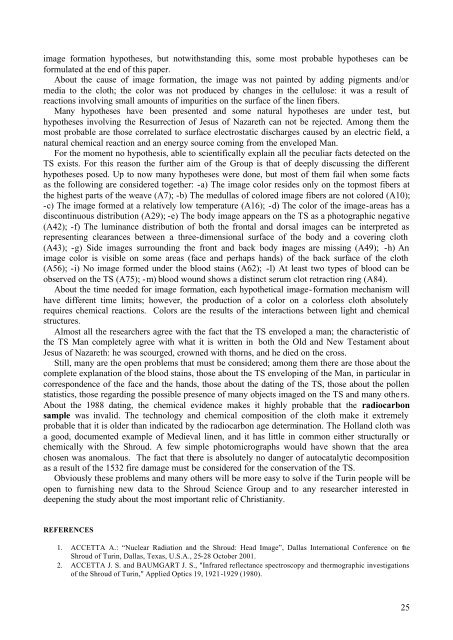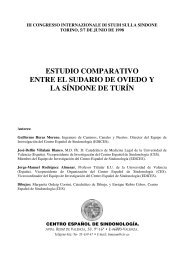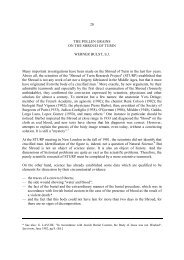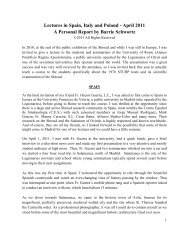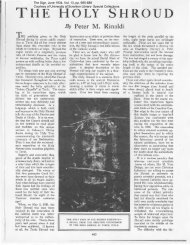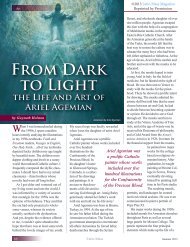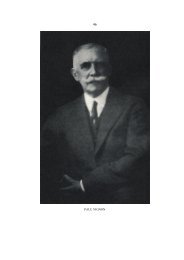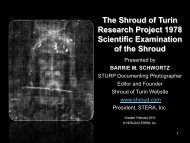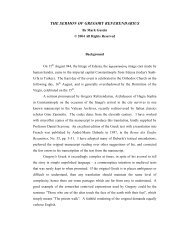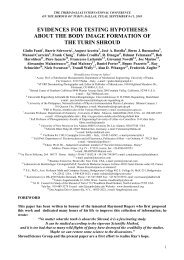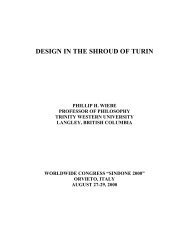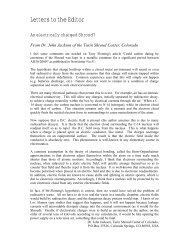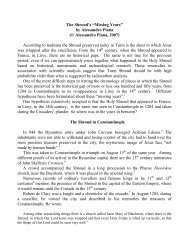list of evidences 10d Barrie - The Shroud of Turin Website
list of evidences 10d Barrie - The Shroud of Turin Website
list of evidences 10d Barrie - The Shroud of Turin Website
You also want an ePaper? Increase the reach of your titles
YUMPU automatically turns print PDFs into web optimized ePapers that Google loves.
image formation hypotheses, but notwithstanding this, some most probable hypotheses can beformulated at the end <strong>of</strong> this paper.About the cause <strong>of</strong> image formation, the image was not painted by adding pigments and/ormedia to the cloth; the color was not produced by changes in the cellulose: it was a result <strong>of</strong>reactions involving small amounts <strong>of</strong> impurities on the surface <strong>of</strong> the linen fibers.Many hypotheses have been presented and some natural hypotheses are under test, buthypotheses involving the Resurrection <strong>of</strong> Jesus <strong>of</strong> Nazareth can not be rejected. Among them themost probable are those correlated to surface electrostatic discharges caused by an electric field, anatural chemical reaction and an energy source coming from the enveloped Man.For the moment no hypothesis, able to scientifically explain all the peculiar facts detected on theTS exists. For this reason the further aim <strong>of</strong> the Group is that <strong>of</strong> deeply discussing the differenthypotheses posed. Up to now many hypotheses were done, but most <strong>of</strong> them fail when some factsas the following are considered together: -a) <strong>The</strong> image color resides only on the topmost fibers atthe highest parts <strong>of</strong> the weave (A7); -b) <strong>The</strong> medullas <strong>of</strong> colored image fibers are not colored (A10);-c) <strong>The</strong> image formed at a relatively low temperature (A16); -d) <strong>The</strong> color <strong>of</strong> the image-areas has adiscontinuous distribution (A29); -e) <strong>The</strong> body image appears on the TS as a photographic negative(A42); -f) <strong>The</strong> luminance distribution <strong>of</strong> both the frontal and dorsal images can be interpreted asrepresenting clearances between a three-dimensional surface <strong>of</strong> the body and a covering cloth(A43); -g) Side images surrounding the front and back body images are missing (A49); -h) Animage color is visible on some areas (face and perhaps hands) <strong>of</strong> the back surface <strong>of</strong> the cloth(A56); -i) No image formed under the blood stains (A62); -l) At least two types <strong>of</strong> blood can beobserved on the TS (A75); -m) blood wound shows a distinct serum clot retraction ring (A84).About the time needed for image formation, each hypothetical image-formation mechanism willhave different time limits; however, the production <strong>of</strong> a color on a colorless cloth absolutelyrequires chemical reactions. Colors are the results <strong>of</strong> the interactions between light and chemicalstructures.Almost all the researchers agree with the fact that the TS enveloped a man; the characteristic <strong>of</strong>the TS Man completely agree with what it is written in both the Old and New Testament aboutJesus <strong>of</strong> Nazareth: he was scourged, crowned with thorns, and he died on the cross.Still, many are the open problems that must be considered; among them there are those about thecomplete explanation <strong>of</strong> the blood stains, those about the TS enveloping <strong>of</strong> the Man, in particular incorrespondence <strong>of</strong> the face and the hands, those about the dating <strong>of</strong> the TS, those about the pollenstatistics, those regarding the possible presence <strong>of</strong> many objects imaged on the TS and many others.About the 1988 dating, the chemical evidence makes it highly probable that the radiocarbonsample was invalid. <strong>The</strong> technology and chemical composition <strong>of</strong> the cloth make it extremelyprobable that it is older than indicated by the radiocarbon age determination. <strong>The</strong> Holland cloth wasa good, documented example <strong>of</strong> Medieval linen, and it has little in common either structurally orchemically with the <strong>Shroud</strong>. A few simple photomicrographs would have shown that the areachosen was anomalous. <strong>The</strong> fact that there is absolutely no danger <strong>of</strong> autocatalytic decompositionas a result <strong>of</strong> the 1532 fire damage must be considered for the conservation <strong>of</strong> the TS.Obviously these problems and many others will be more easy to solve if the <strong>Turin</strong> people will beopen to furnishing new data to the <strong>Shroud</strong> Science Group and to any researcher interested indeepening the study about the most important relic <strong>of</strong> Christianity.REFERENCES1. ACCETTA A.: “Nuclear Radiation and the <strong>Shroud</strong>: Head Image”, Dallas International Conference on the<strong>Shroud</strong> <strong>of</strong> <strong>Turin</strong>, Dallas, Texas, U.S.A., 25-28 October 2001.2. ACCETTA J. S. and BAUMGART J. S., "Infrared reflectance spectroscopy and thermographic investigations<strong>of</strong> the <strong>Shroud</strong> <strong>of</strong> <strong>Turin</strong>," Applied Optics 19, 1921-1929 (1980).25


